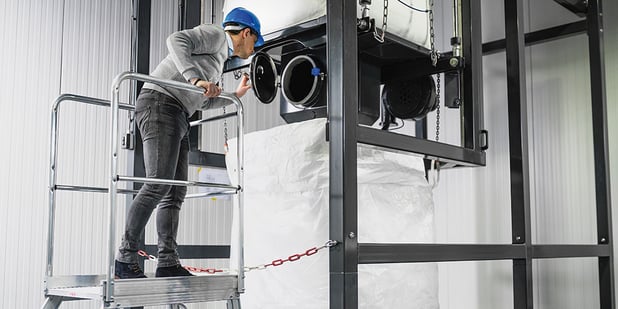
In our earlier blogs, we explained that FIBCs are made of 100% virgin polypropylene, a petroleum-based product, also known as a thermoplastic. Other materials are used as well, but choosing the right material for your FIBC might be easier than you think: Big Bags can be divided into four general categories based on their material: Type A, B, C or D.
Choosing the right type of FIBC depends on many factors, such as the environment of the production plant, where the bags are filled and discharged and the product you want to store. Static electricity also plays a part in choosing the right type. In this blog, we explain the different types to help you choose the perfect packaging.
Static electricity
One of the factors weighing into the choosing of FIBCs, is the control of static electricity. This occurs when electric charges are imbalanced within certain materials. During the filling or discharging of big bags, static electricity can build up. This must be prevented while packing any kind of flammable or combustible products. Read on to find out which type of FIBC suits your needs!
Type A FIBC Bags
If you ask for a standard bag, the Type A bag is the one you will get. These are made from a mixture of polypropylene, calcium carbonate, and UV additive to protect them against erosion when they are stored outside. Type A bags are often used for transporting products that are not flammable in nature. They do not have static protection or other electrostatic safety features. Combustible gases or solvents should not be kept in proximity of these bags.
Type B FIBC Bags
One step further we find the Type B bags. These are also made from standard propylene material but are enabled to prevent sparks. They can have a special anti-static coating: they have a low breakdown voltage (generally below 6kV) which is quite effective in preventing explosive dust-air mixtures from igniting. Nevertheless, these bags can’t dissipate static electricity and can therefore not be labeled as antistatic. They are perfect for the safe transportation of dry and flammable powders but should be kept on a safe distance from flammable gases or solvents. But, even in these bags, customization is possible. Type B bags can also be produced without coating, or with an anti-static liner and regular outer bag.
Type C FIBC Bags
Type C bags are best suited for flammable powders: They are also known as Conductive Jumbo FIBCs, which are produced from fabric which is non-conductive in nature but have conductive threads which are interwoven. They are most often used by chemical companies because they can safely transport highly flammable material — if handled right. During the process of either filling or emptying the bags, they must be kept electrically grounded. When doing so, they are also safe to use in the presence of flammable gasses or solvents.
Type D FIBC Bags
Type D bags are also referred to as antistatic bulk bags or Dissipative FIBC bags. They are like the Type C bags but don't require grounding. The fabric used in Type D bags is completely static dissipator: it automatically dissipates the static charge, rather than gathering it up and causing a spark. They are the go-to choice for combustible substances. Type D bags are also safe to use with flammable solvents or gasses around the bag, but should not be used when the surface has water or grease on it.
Looking for a partner for packaging?
Unsure about which bag is right for your product and process? Our team of experts works towards a perfect packaging solution, completely adapted to your needs. Get in touch to learn more about our approach!
